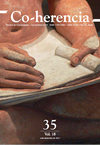Image of the stars. The Epinomis and the central images of the Republic
Main Article Content
Keywords
Epinomis, images of the Republic, Plato, Republic
Abstract
A reading of the Epinomis dialogue is proposed within the context of the three central images of the Republic: the sun, the line and the cave. To do this, we start from the methodological assumption of the authenticity of the dialogue. A schematic summary of its main themes is then provided, according to which the three images of the Republic are explained. On these assumptions, the central thesis is argued: as a dialogue, the Epinomis is situated thematically, methodologically and interpretatively in the mathematical section of the line. In the conclusion it is argued that in this text the dialectic operates as an indication to the first intelligible realm.
Downloads
References
Altman, W. (2012a). Plato the Teacher: The Crisis of the Republic. Lexington Books.
Altman, W. (2012b). Why Plato Wrote Epinomis. Leonardo Tarán and the Thirteenth Book of the Laws. Polis, (29), 83-107. https://doi.org/10.1163/20512996-90000197
Altman, W. (2016). The Guardians on Trial: The Reading Order of Plato’s Dialogues from Euthyphro to Phaedo. Lexington Books.
Aronadio, F. (2013a). L’Epinomide: Struttura compositiva e contenuti teorici. En [Plato] M. Tulli (Ed.), Epinomis (pp. 13-178). Bibliopolis.
Aronadio, F. (2013b). Note di commento. En [Plato] M. Tulli (Ed.), Epinomis (pp. 309-404). Bibliopolis.
Cattanei, E. (2012). Arithmos nell’Epinomide. En F. Alesse y F. Ferrari (Eds.), Epinomide: Studi sull’opera e la sua ricezione (pp. 125-178).
Bibliopolis.
Eggers Lan, C. (2000). El sol, la línea y la caverna. Colihue.
Flórez, A. (2016). ‘Los dos veces siete’. Baquílides y el Fedón de Platón. Universitas Philosophica, 33(67), 53-72. https://doi.org/10.11144/Javeriana.uph33-67.ldvs
Flórez, A. (2019). Platón y Homero: Diálogo entre filosofía y poesía. Editorial Pontificia Universidad Javeriana.
Gantz, T. (1993). Early Greek Myth. A Guide to Literary and Artistic Sources. Vols. 1-2. Johns Hopkins University Press.
Giardina, G. (2012). L’Epinomide negli scritti matematici neopitagorici e neoplatonici. En F. Alesse y F. Ferrari (Eds.), Epinomide: Studi
sull’opera e la sua ricezione (pp. 341-378). Bibliopolis.
Guthrie, W. K. C. (1992). Historia de la filosofía griega. Vol. V: Platón: Segunda época y la Academia. A. Medina González (Trad.). Gredos.
Lavecchia, S. (2007). Sophìa e autocoscienza nel pensiero di Platone. Esercizi Filosofici, (2), 126-136. http://www2.units.it/eserfilo/art207/lavecchia207.pdf
Linguiti, A. (2012). L’Epinomide in autori neoplatonici. En F. Alesse y F. Ferrari (Eds.), Epinomide: Studi sull’opera e la sua ricezione (pp. 379-393). Bibliopolis.
Müller, G. (1951). Studien zu den platonischen Nomoi. C. H. Beck.
Novotný, F. (1960). Platonis Epinomis Commentariis Illustrata. Academia Scientiarum Bohemoslovenica.
Plato. (1997). Epinomis (R. McKirahan, Trad.). En J. M. Cooper (Ed.), Plato. Complete Works (pp. 1617-1633). Hackett.
Platón. (1999). Diálogos. Vol. VIII: Leyes, i-vi; Vol. IX: Leyes, vii-xii. (F. Lisi, Trad.). Gredos.
[Plato]. (2013). Epinomis. M. Tulli (Ed.); F. Aronadio (Trad.). Bibliopolis.
Platón. (2006). República (J. M. Pabón y M. Fernández-Galiano, Trads.). Centro de Estudios Constitucionales.
Repellini, F. F. (2012). La “vera” astronomia e la sapienza. En F. Alesse y F. Ferrari (Eds.), Epinomide: Studi sull’opera e la sua ricezione (pp. 59-91). Bibliopolis.
Spinassi, M. Á. (2021). En el recinto común dedicado a Apolo y Helios (Platón, Lg. 945b-948b). Nova Tellus, 39(2), 73-92. https://bit.ly/3mlEzth
Tarán, L. (1975). Academica: Plato, Philip of Opus, and the Pseudo-Platonic Epinomis. American Philosophical Society.
Zuckert, C. (2009). Plato’s Philosophers: The Coherence of the Dialogues. The University of Chicago Press.





